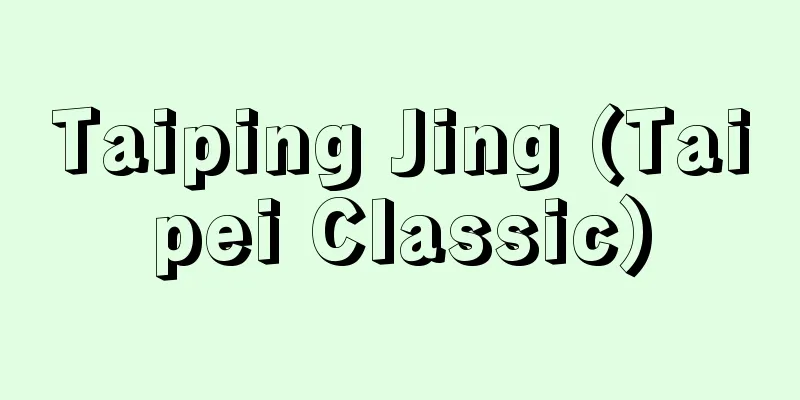Horse-borrower

|
A transportation business using horseback that was active from the late Heian period to the Sengoku period. The word bashaku appears in the Shin Sarugaku-ki, which was compiled in the 11th century, and they were based in important transportation points, ports, and post towns, mainly in the Kinai region, such as Otsu, Yodo, and Yamazaki. According to the Kangaku-kojojo, a record of a lecture on education held at Enryaku-ji Temple on Mount Hiei, bashaku traveled from Tsuruga to Kaizu in the north of Kohoku with 13 horses, and were active as a group. In 1270 (Bun'ei 7), their fee was one koku of rice per ta, about one to four or five sho, and if the fee was reduced, it was illegal to reduce the amount of rice. According to the Nishino documents, which describe the business activities of the bakusha, the bakusha group of Echizen Konoura, who were active on the Hokuriku Kaido, created the "Ura, Yamauchi Bakusha Sadamegaki" in 1508 (Eisho 5), which states that they were not limited to simply transporting goods, but also had the exclusive right to sell salt and kure. This exclusive right was further guaranteed in the same year by Echizen's warring lord Asakura Sadakage, and they became known as "Kubo-sama Bakusha Chu" and made the area around the Hokuriku Kaido their trading area. At the same time, they were also obligated to maintain the road. With their power in transportation as a backdrop, the bakusha often staged bakusha uprisings to protect their own economic activities. It was due to their daily activities that the horse-lending uprising that occurred in Yamashiro Province in 1466 (Bunsho 1) was able to close the routes to Kyoto and Nara. [Atsuko Suzuki] "Toyoda Takeshi, 'Merchants and Transportation in the Middle Ages' (1983, Yoshikawa Kobunkan)" ▽ "Sasaki Ginya, 'Japanese History 13: Muromachi Shogunate' (1975, Shogakukan)" ▽ "Wakida Haruko, 'On Shipping in Tsuruga Bay' (Fukui Prefectural Library, included in 'Research on the History of Shipping in the Sea of Japan' edited by Fukui Prefectural Local History Discussion Group, 1967, Fukui Prefectural Local History Discussion Group)" Source: Shogakukan Encyclopedia Nipponica About Encyclopedia Nipponica Information | Legend |
|
平安後期から戦国期まで活躍した馬の背を利用する交通運輸業者。11世紀に成立した『新猿楽記』に馬借の語がみえ、大津(おおつ)・淀(よど)・山崎(やまざき)など畿内(きない)を中心とした交通の要衝や港・宿場を活動の拠点とした。比叡山延暦寺(ひえいざんえんりゃくじ)で勧学講(かんがくこう)が行われた際の記録である『勧学講条々』によれば、敦賀(つるが)から湖北の海津(かいづ)への馬借は馬13疋(びき)で一類をなして活動していたが、1270年(文永7)の彼らの駄賃は米一駄一石当り、一斗から一斗四、五升ほどで、駄賃を少なくすると、米を不法に減じたという。また馬借の営業活動を伝えている『西野(にしの)文書』によると、北陸街道で活躍した越前河野浦(えちぜんこうのうら)の馬借集団は1508年(永正5)「浦、山内(やまうち)馬借定書(さだめがき)」を作成しているが、これによると、彼らは単に物資輸送だけにとどまらず、塩・榑(くれ)の独占販売権をもっていた。この独占権は、同年さらに越前の戦国大名朝倉貞景(あさくらさだかげ)からも保障され、「公方(くぼう)様馬借中(ちゅう)」と称して、北陸街道を中心とした地域を商圏とした。その一方彼らには街道整備の義務も課せられていた。馬借はこのような交通運輸上にもつ実力を背景として、自己の経済活動を守るために、しばしば馬借一揆(いっき)を繰り返した。1466年(文正1)に山城(やましろ)国で起きた馬借一揆が京や奈良への通路を閉鎖できたのは、こうした彼らの日常活動によるものである。 [鈴木敦子] 『豊田武著『中世の商人と交通』(1983・吉川弘文館)』▽『佐々木銀弥著『日本の歴史13 室町幕府』(1975・小学館)』▽『脇田晴子「敦賀湾の海運について」(福井県立図書館、福井県郷土誌懇談会編『日本海海運史の研究』所収・1967・福井県郷土誌懇談会)』 出典 小学館 日本大百科全書(ニッポニカ)日本大百科全書(ニッポニカ)について 情報 | 凡例 |
Recommend
Juno (English spelling)
An ancient Italian goddess identified with Hera in...
Chateau d'eau (English spelling) chateau de eau
…The Adamawa Plateau, which divides the country i...
Pereira, Aristides Maria
Born 1924. Boa Vista, Cape Verde. A liberation mov...
Cantonese dialect - Etsuhogen
…The semantic evocation of romanized spelling, ev...
Geiger, A.
...His successors found ideological agreement wit...
Shigetaka Itakura
1667 * -1713 A daimyo from the early to mid-Edo p...
Hot stone - Onjaku
A tool for warming the body. Serpentine stones ar...
Nickel dimethylglyoxime
Chemical formula: [Ni(C 4 H 7 N 2 O 2 ) 2 ]. Dimet...
Role playing
...Large companies began to integrate employee ed...
Approximation formula
It has three meanings: (1) a "substitute for...
Parish General Assembly - Kyokusoukai
…Parish administration was carried out by the par...
Ekacesium - Ekacesium
... Periodic table element symbol = Fr, atomic nu...
《Asian Drama》 - Asian Drama
…His research fields as a scholar are wide-rangin...
Niseko [town] - Niseko
A town in Abuta District, Hokkaido. Formerly calle...
Volos
… [Origin of the Gods] The Primary Chronicle (als...









